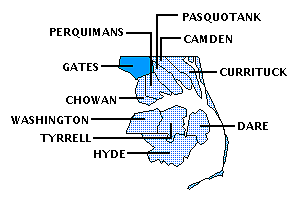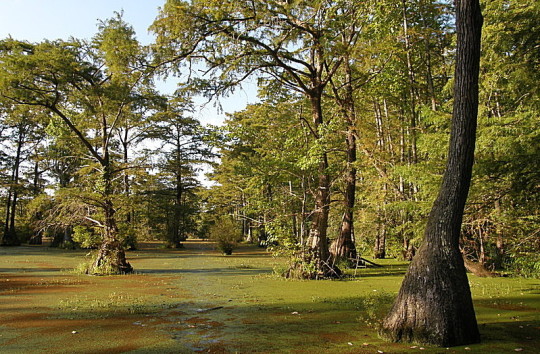GATES COUNTY
Scroll down this page or click on specific site name to view features on the following Gates County attractions/points of interest:
Great Dismal Swamp National Wildlife Refuge, Merchants Millpond State Park
Fast facts about Gates County:
Created in 1779, the county is named for American General Horatio Gates, commanding officer at the Battle of Saratoga.
The county seat is Gatesville. Other communities include Corapeake, Eure, Hobbsville, and Sunbury.
Gates County’s land area is 340.61 square miles; the population in the 2010 census was 12,197.
The Great Dismal Swamp National Wildlife Refuge [GDSNWR] covers more than 110,000 acres of forested wetlands in southeastern Virginia and northeastern North Carolina, including the northeastern tip of Gates County. The GDSNWR was established in 1974 to protect the swamp’s important ecosystem. Along with such year-round inhabitants as black bears and bobcats, the refuge provides a rest area for migratory birds in spring and fall. Many former logging roads cross the Refuge and provide good opportunities for hiking, biking, and wildlife observation. Trails are open daily from sunrise to sunset. The Refuge office is located on Desert Road in Suffolk, Virginia. 757-986-3705
East of Gatesville
Merchants Millpond State Park, located in the heart of Gates County in northeastern N. C., offers a ready escape from the frantic pace of the 21st century. Here, visitors can find peace and solitude among still waters and moss-draped cypress. The park, established in 1973, covers more than 2,600 acres and protects one of the state’s most diverse ecological environments, a merging of swamp forest and coastal pond. Even for rural eastern North Carolina, the park seems especially remote and cut off from the modern world. The park derives its name from the millponds that were built in the area in the early 1700s. To meet the needs of the region’s earliest settlers, gristmills, a saw mill, a farm supply store, and other businesses were established around the millpond, making the area a center for trade. Hunter’s Millpond was the first to be built, sometime before 1720. It survived until 1922, when it was destroyed by highway construction. Kinchen Norfleet built another millpond in 1811. A gristmill and sawmill soon followed. Originally called Norfleet’s Millpond, the commercial center eventually became known by the more generic sobriquet Merchants Millpond. Nothing remains today of these 19th century enterprises.
Instead, the park is largely undeveloped, making it easy for visitors to get a sense of having “returned to nature.” Canoes af-ford one of the best ways to enjoy the park, and rentals are available by the hour or the day at the small station adjacent to the park’s only boat ramp. Guests can paddle the tranquil waters of the shallow pond, studded with ancient bald cypress and gum trees and covered with drifting mats of yellow cow lilies, duckweeds, and water ferns. More venture-some visitors can follow slow-moving Bennetts Creek through the even more isolated region of Lassiter Swamp. Many trees in this area of the park range from 500 to 1,000 years in age. An equally rewarding means of enjoying the sights is by walking one of the park’s three hiking trails. All are flat and easy, meandering along the shores of the pond or through the park’s more wooded areas.
Merchants Millpond is a wilder-ness sanctuary, home to a variety of plants and animals sure to delight sharp-eyed visitors. Two primitive species of fish – the long-nosed gar and the bowfin – share the pond with numerous species of pond turtles, frogs, and water snakes. Towering gum cypress trees, “decorated” with Spanish moss and mistle-toe, make Lassiter Swamp a mysterious, mystical wonderland, while skirting the park at higher elevations are stands of American beech, loblolly pine, red maple, and yellow poplar. More than 200 bird species, including hawks, owls, woodpeckers, egrets, and an assortment of waterfowl find refuge among the millpond’s woods and waters. Along with canoeing and hiking, the park also permits fishing. Boating and fishing are subject to the regulations of the Wildlife Resources Commission, which manages the millpond’s fisheries. Camping and picnic facilities are available on a first-come basis. The park opens daily at 8 AM year-round; closing hours vary seasonally. Brochures published by the state warn visitors to guard against ticks, especially during warm months, by wearing light colored clothing (making the tick easier to spot), long sleeves, and long pants. Insect repellant is also an obvious recommendation. 252-357-1191
Gates County is bordered by CAMDEN, CHOWAN, HERTFORD (Region Two), PASQUOTANK, and PERQUIMANS counties.
Return to REGION ONE HOME PAGE.
Return to GEOGRAPHIC REGIONS HOME PAGE.







